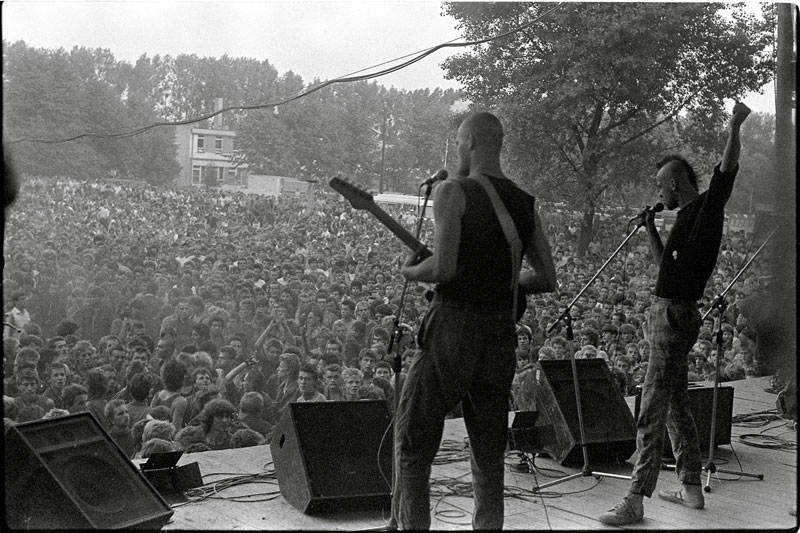By Tom Junes
The botched axing of “Your Pain is Better Than Mine”, a song by Polish rockstar Kazik Staszewski critical of ruling party chairman Jarosław Kaczyński’s behaviour during the coronavirus crisis, recently flared up emotions in Poland.
The manager of state-run station Polskie Radio 3 – commonly known as Trójka – through a clumsy attempt at censoring the song, in fact provoked a veritable “Streisand Effect”, drawing far more attention to it.
The affair quickly morphed into a political spectacle, fuelled by popular outrage on social media, a boycott by recording artists, and protests from employees, including some DJs who quit the station.
Criticism came from friend and foe alike. Not only the opposition, but also the Polish president, prime minister, and two deputy prime ministers all publicly denounced what had happened.
The statements appeared as half-hearted attempts to depoliticise what had clearly been an embarrassing act of sycophancy and incompetence. Over past years the same politicians have had no qualms when subverting Poland’s public broadcasters into propaganda tools. Yet this time their discomfort may have been genuine.
The concern stemmed from the fact that both the radio show – Trójka’s legendary weekly hits parade – and the musician in question – frontman of the legendary rock band Kult – hail from the iconic and subversive music scene of communism’s final decade in Poland. That same period moulded the political identity of senior figures in the ruling Law and Justice (PiS) party.
The scandal thus invited comparisons with the political censorship of culture during the communist era, and it did not take long for Trójka’s critics to start throwing them around.
“If a song brings back the worst communist practices, which I know only from books and stories, then I think that my music should not be played by the same station”, wrote Dawid Podsiadło, Poland’s best-selling artist last year and one of those who boycotted Trójka in protest.
Equating PiS’s cultural interventions to the communist regime has become something of a standard rhetorical device among the party’s opponents. Yet, some of the reactions – such as the radio station’s former director comparing the ruling party’s “methods” to Stalinism – threatened to go overboard in their stretched analogy and overblown pathos.
For one, the whole episode did not come even close to the experience of life under Stalinism. Such overdramatised claims can be seen as an insult to the victims of the era. Moreover, neither sycophancy nor censorship are a unique feature of communist dictatorships.
From The Cruise (Rejs) to Day Of The Wacko (Dzień Świra), via Sexmission (Seksmisja) and Teddy Bear (Miś) – @culture_pl looks at Poland's most beloved comedies, many of which provided an outlet for criticism of the communist regime https://t.co/llmJT6WcJh
— Notes from Poland 🇵🇱 (@notesfrompoland) October 5, 2018
In Poland under communist rule, censorship was institutionalised through the activity of the Main Office for the Control of Press, Publications and Shows (Główny Urząd Kontroli Prasy, Publikacji i Widowisk) which operated with an elaborate set of instructions and prohibitions, as revealed in the erstwhile émigré publication of the Black Book of Censorship in the Polish People’s Republic (Czarna księga cenzury PRL).
Communist Poland was a surveillance state, albeit not a very effective one. At times, foreign visitors could expect their mail to be read (as was done to thousands of participants in the 5th World Festival of Youth and Students) and a few students could be expelled for criticising the regime in personal correspondence to relatives.
Sometimes self-censorship was even more harmful than the redactions of the censor’s office, as when the student periodical Po Prostu did not go to print with its usual front-page layout after Stalin’s death (which would then read “Po Prostu … Zmarł Stalin”, or Stalin Simply Died), but rather moved the paper’s title from the customary header to the bottom of the page.
But generally, the Polish security apparatus was less efficient and pervasive than corresponding institutions in neighbouring communist countries. Censorship was also openly contested. In the sixties, intellectuals openly criticised tighter cultural censorship and restrictions on paper allocations for publications, as in the notorious “Letter of 34”, while later in the decade the banning of Adam Mickiewicz’s classical play Forefathers’ Eve (Dziady) provided the spark that set off a nationwide student revolt in 1968.
The communist regime’s censorship was undermined through the broadcasts of foreign radio stations like the BBC and Radio Free Europe, which were not jammed in post-Stalinist Poland. Western TV shows that were broadcast on national television, like the police series Kojak in 1970s, unwittingly proved to be a subversive influence in the face of the decade’s “propaganda of success”.
Also, in the 1970s, Poland saw the emergence of the most widespread and variegated independent publishing – samizdat – phenomenon in the whole Soviet bloc.
It is important to note that some years were more oppressive, and others more liberal. When it came to culture and music in particular, much in fact depended on a wide variety of factors ranging from calculated political expediency, an – admittedly “antisocialist” – desire for profit, to even the personal tastes of the regime’s leadership.
With destalinisation came a tolerance of jazz, which in turn opened the door for rock ‘n’ roll – though its Polish version was preventatively named “big beat” so as not to arouse the authorities’ suspicion.
Though the regime was still wary of new youthful trends, as the sixties progressed a Polish brand of rock was allowed to flourish. Polish bands were even allowed to cross the Iron Curtain, and western bands like the Rolling Stones – despite provoking riots in Warsaw – could come and play in Poland.
The 1970s saw less promotion of rock music (it was said that party leader Edward Gierek was not keen on the genre), but Poland’s then “opening to the West” ensured that its popularity did not decline. New trends appeared in Poland nearly as soon as they had on the other side of the Iron Curtain.
When the country slid into crisis towards the end of the decade, there was already a growing rebellious rock scene giving voice to the resentment of the younger generation. It was at this point that the regime used rock music, with all its rebellious potential, as a “safety valve”.
Punk rock bands could record albums in state-run studios while not even martial law in the early 1980s impeded the organisation of the now legendary rock festival in the town of Jarocin.
This vivid rock scene full of angry youthful contestation is one of the remarkable phenomena of 1980s communist Poland. Despite the repression following the military coup, dozens of artists and bands were able to perform and have their music popularised.
A major factor in this was Trójka’s “Lista Przebojów” (Hit List), which since 1982 has been presented by Marek Niedźwiecki, who has now quit the station over the Kazik affair.
The show achieved cult status in these years and the communist authorities were well aware of it. When Lady Pank, another iconic band, saw their song “Less Than Zero” rise in the Lista Przebojów charts in the wake of the politically motivated murder of Grzegorz Przemyk, an opposition activist’s teenage son, the security apparatus launched an investigation into the song’s allusions.
However, archival evidence (handwritten notes on the document in question) suggests that banning the song was dismissed as that would risk increasing its popularity. And while Niedźwiecki attested years later that there were instances of pressure and censorship (though these were most often circumvented in creative ways) in those years, there was no evidence of attempts to push “Less Than Zero” out of the charts.
It seems that the communist regime understood more clearly the potential political fallout of suppressing popular culture than some of PiS’s current appointees. The regime saw rock music as a way to contain revolt, not to incite it.
When in early 1988 a wave of strikes spread throughout the country (which would ultimately lead to the demise of the communist regime), the minister responsible for youth affairs at the time, Aleksander Kwaśniewski, suggested that more rock concerts needed to be organised. They were simply emblematic for the era.
So do comparisons of the axing of Kazik’s song with communist-era censorship make sense? Only in a very superficial way: in so far as a song was perceived as a threat because it voiced public criticism of those in power.
Yet something else has also changed, pushing the pro-active and institutional model of PRL censorship further into history books: the internet. One could hardly imagine the kind of “Streisand Effect” in the bygone era, because of today’s media ecosphere.
Within a day, the song saw its views on YouTube increase five times to over five-and-a-half million. Kazik himself admitted that Trójka’s decision had given him the kind of promotion for which he would need to pay millions. The ham-fisted censorship proved counter-productive to the censors.
Meanwhile, Trójka has seen another personnel overhaul in the wake of the scandal and the radio’s newly appointed director, Kuba Strzyczkowski, has publicly apologised to Niedźwiecki and others in the hope to convince them to return. Perhaps some lessons from the communist era have been drawn?
Main image credit: Mirosław Makowski/Wikimedia Commons (under CC BY-SA 3.0)





















